穆涅略斯自然保护区,西班牙 Muniellos Nature Reserve in Asturias, Spain (© Andres M. Dominguez/Minden Pictures)
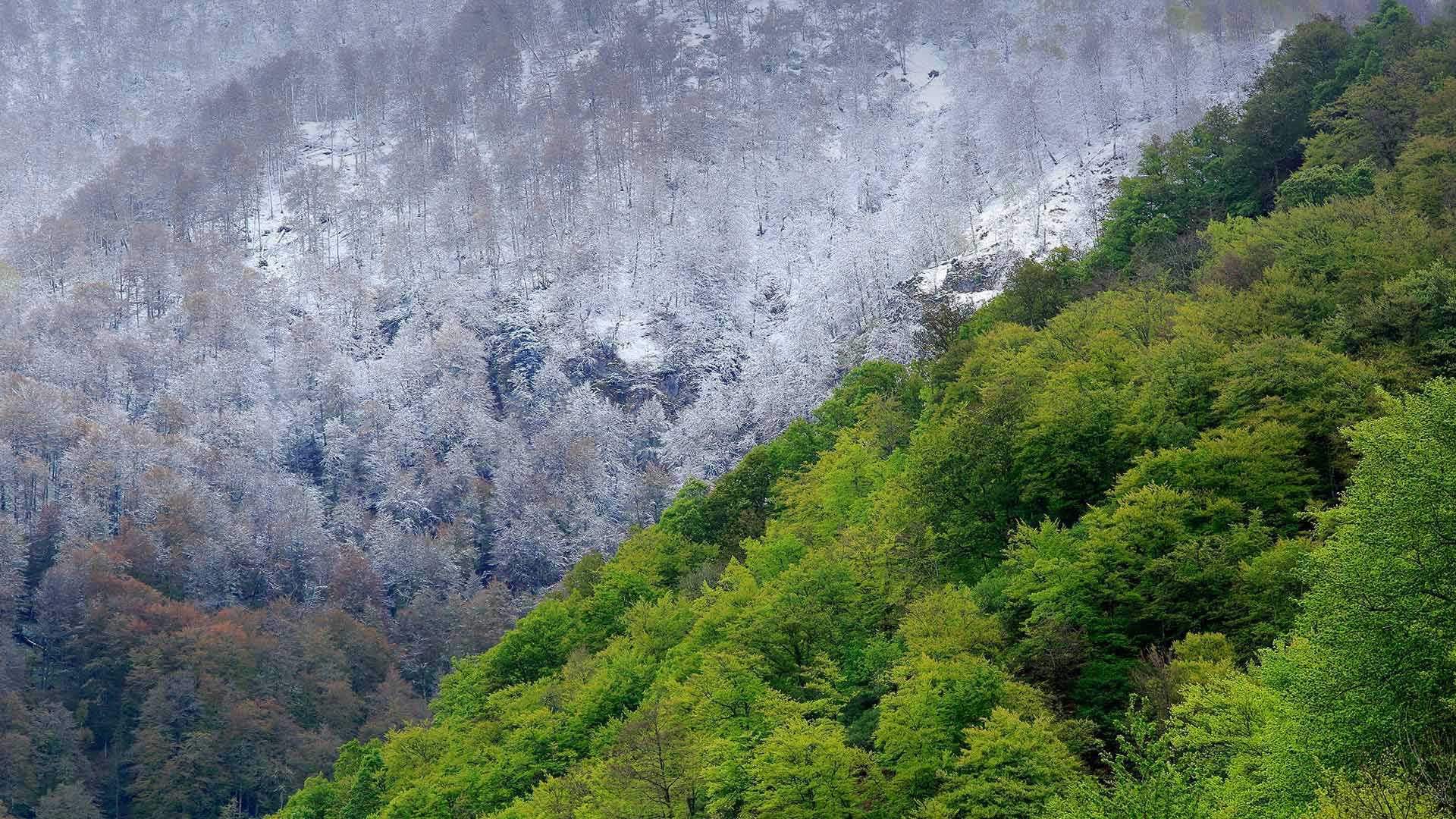
穆涅略斯自然保护区,西班牙 Muniellos Nature Reserve in Asturias, Spain (© Andres M. Dominguez/Minden Pictures)
树木之美 Beauty comes in trees
穆涅略斯自然保护区,西班牙
穆涅略斯自然保护区有西班牙保护最好的栎树森林之一。栎树也被称作普通橡树、欧洲橡木或英国橡树。除橡树外,这片面积13560英亩的保护区内还有无梗花栎。
20世纪70年代起,穆涅略斯自然保护区便禁止伐木和打猎。如今,这里被联合国教科文组织列为生物圈保护区,进入其中的人数都被严格控制。保护区内设有游客中心,大多数游客最远也就能被允许走到这里。因此今天的这张照片,可以说非常珍贵。
Muniellos Nature Reserve
The Muniellos Nature Reserve is one of Spain's best-preserved forests of Quercus robur, otherwise known as common oak, European oak, or English oak. The 13,560-acre reserve in Asturias province also includes sessile oaks, seen in our photo alongside beech trees.
In the 1970s logging was banned in the reserve. Soon after, hunting was also banned. Today, even human access to this UNESCO-designated biosphere is carefully controlled. There's a visitor center, and that's about as far as most tourists are allowed. We're just glad we have photos of this incredible forest.
奥尔德萨和佩尔迪多山国家公园里的瀑布,西班牙比利牛斯山脉 Waterfall on the Rio Arazas in Ordesa y Monte Perdido National Park, Pyrenees, Spain (© David Santiago Garcia/Cavan Images)

奥尔德萨和佩尔迪多山国家公园里的瀑布,西班牙比利牛斯山脉 Waterfall on the Rio Arazas in Ordesa y Monte Perdido National Park, Pyrenees, Spain (© David Santiago Garcia/Cavan Images)
通往伊比利亚的门户 Gateway to Iberia
西班牙比利牛斯山脉奥德萨和蒙特佩迪多国家公园的里奥·阿拉扎斯
比利牛斯山脉在任何季节都很引人注目,但在夏季温暖持续到秋季的年份尤其美丽,自最早的文明在那里扎根以来,比利牛斯半岛一直是伊比利亚半岛和欧洲其他地区之间的天然边界。位于山脉中心的Ordesa y Monte Perdido国家公园创建于1918年,并于1982年扩建。如今,它已成为联合国教科文组织的世界遗产。
该公园拥有陡峭的悬崖和深邃、翠绿的山谷,是摄影师的梦想,拥有由比利牛斯山脉剧烈的海拔变化形成的卓越地质地貌和多样生态。该地区是几个只能在这里找到的物种的家园,包括比利牛斯羚羊和比利牛斯山羚羊,或水鼹鼠。这种被认为是该地区最稀有和最重要的哺乳动物,布卡多山羊或比利牛斯山羊,尽管进行了保护工作,但于2000年1月灭绝。
Rio Arazas in Ordesa and Monte Perdido National Park, Pyrenees, Spain
Striking in any season, but particularly beautiful in years when the warmth of summer stretches into fall, the Pyrenees have served as a natural border between the Iberian Peninsula and the rest of Europe since the earliest civilizations took root there. Located in the center of the range, the Ordesa y Monte Perdido National Park was created in 1918 and expanded in 1982. Today it is a UNESCO World Heritage Site.
Boasting sheer cliffs and deep, verdant valleys, the park is a photographer's dream, with a landscape marked by remarkable geological landforms and diverse ecologies shaped by the drastic elevation changes of the Pyrenees. The region is home to several species that can only be found here, including the Pyrenean chamois and the Pyrenean desman, or water mole. The mammal considered the most rare and important in the region, the bucardo or Pyrenean ibex, went extinct in January 2000 despite preservation efforts.
巴斯克海岸世界地质公园的比斯开湾,西班牙 Bay of Biscay in the Basque Coast Geopark near Bilbao, Spain (© Olimpio Fantuz/eStock Photo)
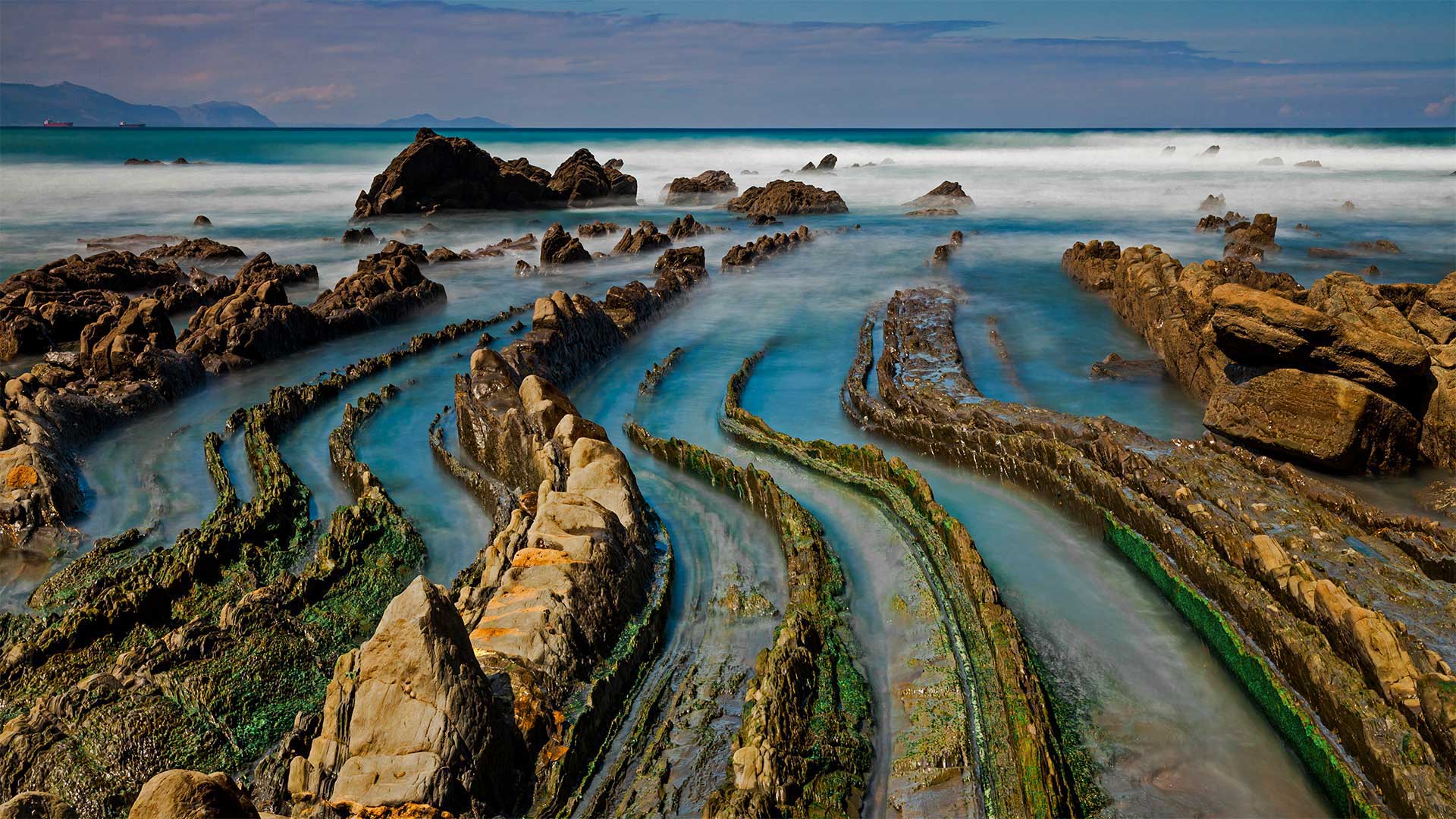
巴斯克海岸世界地质公园的比斯开湾,西班牙 Bay of Biscay in the Basque Coast Geopark near Bilbao, Spain (© Olimpio Fantuz/eStock Photo)
隐入大海的龙尾 Dragon tails trail to the sea
国际地理多样性日
这些龙尾巴状的结构延伸至西班牙北部巴斯克海岸的比斯开湾,是地球上最独特、最引人注目的地质构造之一。对于地质学家和喜欢看冰凉岩石的人来说,这是一个仙境。巴斯克海岸地质公园(Basque Coast Geopark)在导游的带领下,游客可以发现6000万年不间断的地质历史。
今天是国际地球多样性日,它揭示了地球科学在解决人类今天面临的重大挑战方面的重要性。这可以包括地质学、岩石圈、地球内部大规模结构以及大气、水圈和生物圈的研究。
International Geodiversity Day
These dragon tail-like structures that stretch into the Bay of Biscay on the Basque Coast of northern Spain are part of one of the most unique and remarkable geological formations on the planet. It's a wonderland for geologists, and for people who just like looking at cool rocks. Guided tours of the Basque Coast Geopark allow visitors to discover 60 million years of uninterrupted geological history.
Today is International Geodiversity Day, which brings to light the importance of geoscience in solving major challenges that humanity is facing today. This can include the study of geology, the lithosphere, and the large-scale structure of Earth's interior, as well as the atmosphere, hydrosphere, and biosphere.
从塞维利亚的都市阳伞俯瞰城市,西班牙 View of the city from the Setas de Sevilla (Metropol Parasol) in Seville, Spain (© LucVi/Shutterstock)
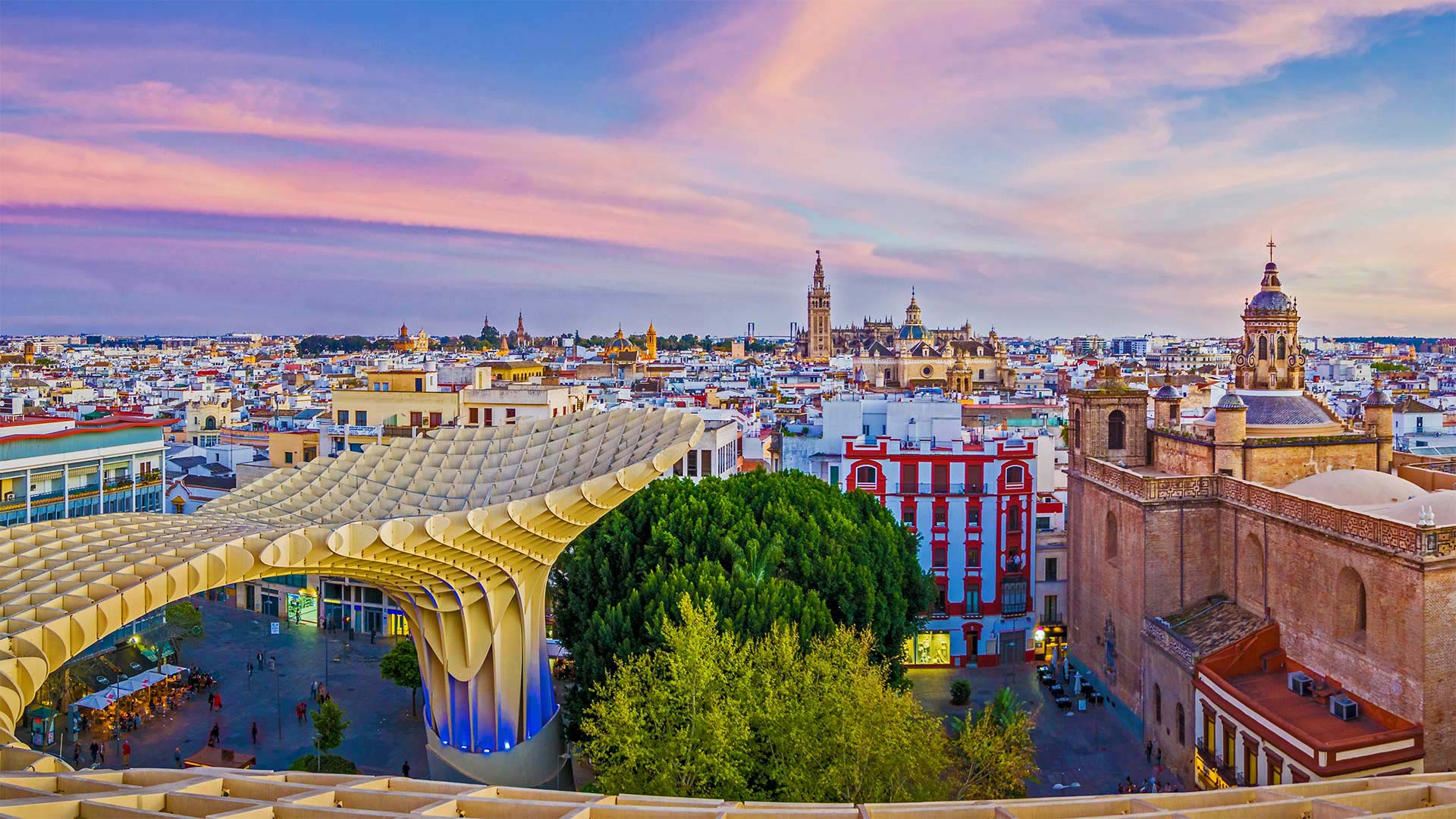
从塞维利亚的都市阳伞俯瞰城市,西班牙 View of the city from the Setas de Sevilla (Metropol Parasol) in Seville, Spain (© LucVi/Shutterstock)
500年前,是谁回到了这座城市? What returned to this city 500 years ago?
Seville, Spain
The first recorded expedition to circumnavigate the Earth set sail from Seville, Spain—seen in our homepage image—500 years ago on this day. 'Yes!' you cry, 'Ferdinand Magellan!' Well, you're partly right.
While Magellan gets the glory as leader of the Spanish expedition, he didn't actually complete the marathon voyage—he was killed in a fight in the Philippines in March 1521. His place as leader of the five-ship voyage was filled by Juan Sebastián de Elcano, whose command ship the 'Vittoria' was the only one in the convoy that survived the trip, reaching Seville in 1522. Harsh conditions and poor-quality vessels had taken their toll: Of the 239 crew members who set out, only 18 returned with the expedition.
Although he only made half of this globe-circling journey, Magellan is rightly honored as an outstanding navigator, especially given the rudimentary knowledge and tools of the time. He discovered and crossed the strait that now bears his name near the tip of South America, trailblazing the first known passage between the Atlantic and Pacific oceans. Magellan's and de Elcano's combined effort was also the first practical proof of a notion many 16th century people were still skeptical about: The Earth is round.
西班牙塞维利亚
500年前的今天,第一次有记录的环绕地球的远征从西班牙塞维利亚启航是的你哭了,“费迪南德·麦哲伦!”嗯,你说得有点对。
虽然麦哲伦获得了西班牙远征队队长的荣誉,但他实际上并没有完成马拉松之旅。他于1521年3月在菲律宾的一场战斗中丧生。他的五艘船航行的领导者由胡安·塞巴斯蒂安·德·埃尔卡诺(Juan Sebastián de Elcano)担任,他的指挥船“维托利亚号”是车队中唯一一艘幸存下来的船,于1522年抵达塞维利亚。恶劣的条件和劣质的船只造成了他们的损失:在出发的239名船员中,只有18人随探险队返回。
尽管麦哲伦只完成了这次环球航行的一半,但他被誉为杰出的航海家,特别是考虑到当时的基本知识和工具。他发现并穿越了现在以他的名字命名的海峡,在南美洲的尖端附近,开辟了已知的第一条大西洋和太平洋之间的通道。麦哲伦和德·埃尔卡诺的共同努力也是16世纪许多人仍然怀疑的一个概念的第一个实际证明:地球是圆的。
加利西亚省科斯塔达莫尔特的灯塔,西班牙 Faro de Playa Lago, Costa da Morte, Muxia, Galicia, Spain (© Carlos Fernandez/Getty Images)
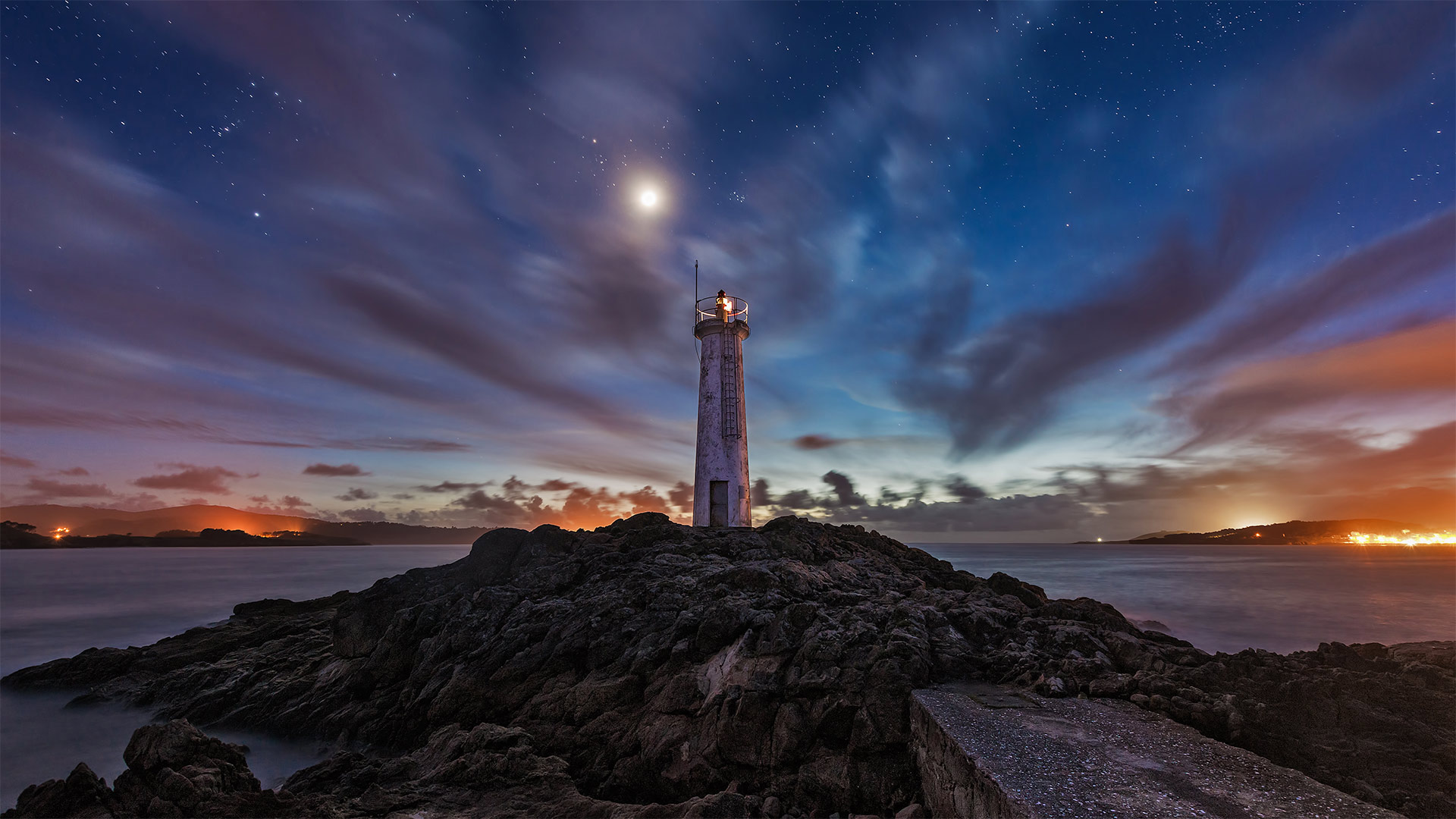
加利西亚省科斯塔达莫尔特的灯塔,西班牙 Faro de Playa Lago, Costa da Morte, Muxia, Galicia, Spain (© Carlos Fernandez/Getty Images)
死亡海岸 The Coast of Death
International Lighthouse Day
This solemn beacon set atop a rocky outcropping is in a country usually associated with sand and sun, making this a side of Spain many do not often see. We're looking out at the sea on the Costa da Morte, or Coast of Death, a nasty name for an equally nasty (but beautiful!) stretch of Galician coastline in the extreme northwest of Spain. We're featuring Costa da Morte on International Lighthouse Day because mariners are never happier to see a lighthouse than when they're sailing this coast, known as the Bermuda Triangle of the Eastern Atlantic.
The Costa da Morte is known for its lighthouses, like this one, called Faro de Playa Lago, one of many strung along 125 miles of coast from Finisterre in the south to Malpica in the north. As a devourer of ships, the Costa da Morte is prolific. Since the 14th century, more than 600 shipwrecks have been documented resulting in the loss of thousands of lives. This corner of Spain lies at the southern end of the Bay of Biscay, also known for its rough waters. The rocky Costa da Morte faces the open North Atlantic and takes the brunt of big ocean swells. (The famous big-wave surf break at Nazare, Portugal, is only a few hundred miles to the south.) Deep waters turn to shallow waters quickly near this rocky cliff-strewn coast, known for its strong currents and hidden rocks. The fog can roll in quickly. Storms form frequently. And hurricane-force winds are not uncommon.
Cool, rainy, and rocky, the Galicia region of Spain is more 'Lord of the Rings' than Club Med. Hiking along this coast, you might feel like you're Scotland rather than Spain, and is compounded by the fact that Galicians themselves are considered a Celtic ethnic group. To visit the lighthouses of Costa da Morte, you can walk a trail appropriately called Camino dos Faros (Road of the Lighthouses). While satellite technology and electronic instruments vastly changed how safely we can now navigate the seas, lighthouses are still vital to boating and the maritime industry. Plus, they're just darn good-looking.
国际灯塔日
这座庄严的灯塔矗立在岩石露头上,位于一个通常与沙子和太阳联系在一起的国家,这使它成为许多人不常看到的西班牙的一面。我们看到的是死亡海岸(Costa da Morte)上的大海,这是一个同样令人讨厌的名字(但很漂亮!)西班牙西北端的加利西亚海岸线。我们在国际灯塔日特别报道科斯塔·达·莫特,因为水手们在这个被称为东大西洋百慕大三角的海岸航行时,看到灯塔最开心。
Costa da Morte以其灯塔而闻名,比如这座被称为Faro de Playa Lago的灯塔,它是从南部的菲尼斯特尔到北部的马尔皮卡沿海岸线125英里的众多灯塔之一。作为船舶的吞噬者,科斯塔·达·莫特是多产的。自14世纪以来,已有600多艘沉船被记录在案,导致数千人丧生。西班牙的这个角落位于比斯开湾的南端,也因其汹涌的海水而闻名。多岩石的Costa da Morte面对开阔的北大西洋,首当其冲地承受着巨大的海浪冲击。(葡萄牙纳扎尔著名的巨浪冲浪场位于南面几百英里处。)在这片岩石峭壁遍布的海岸附近,深水迅速转变为浅水,以其强劲的水流和隐藏的岩石而闻名。雾很快就会卷进来。风暴经常形成。飓风强度的风并不罕见。
凉爽、多雨、多岩石的西班牙加利西亚地区与其说是地中海俱乐部,不如说是“指环王”。沿着这条海岸远足,你可能会觉得自己是苏格兰人而不是西班牙人,这是因为加利西亚人本身被视为凯尔特人。要参观Costa da Morte的灯塔,你可以走一条名为Camino dos Faros(灯塔之路)的小径。虽然卫星技术和电子仪器极大地改变了我们现在在海上航行的安全程度,但灯塔对划船和海运业仍然至关重要。而且,他们真是太漂亮了。
圣埃尔姆附近的潘塔留岛鸟瞰图,西班牙马略卡岛 Aerial view of the island Pantaleu near Sant Elm, Mallorca, Spain (© Dimitri Weber/Azing航空公司)
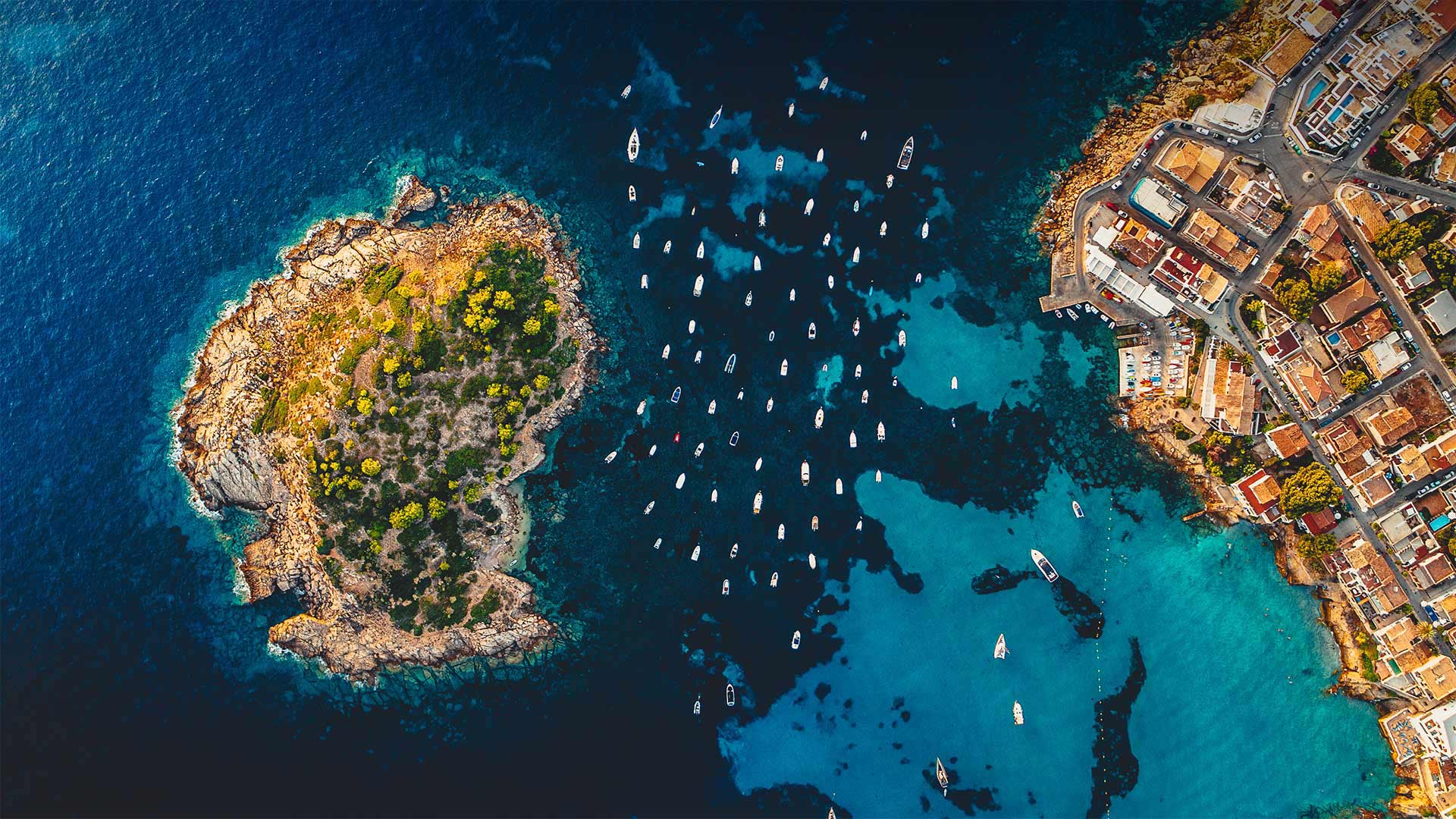
圣埃尔姆附近的潘塔留岛鸟瞰图,西班牙马略卡岛 Aerial view of the island Pantaleu near Sant Elm, Mallorca, Spain (© Dimitri Weber/Azing航空公司)
汪洋中的小岛 Little Island, Big Sea
Pantaleu
There isn't much to the tiny island of El Pantaleu (or Es Pantaleu in Catalan), cast off the westernmost shore of Mallorca, itself a relatively small island only 30-40 miles across. Pantaleu and Mallorca are part of the archipelago of Balearic Islands in the Balearic Sea, off the east coast of Spain. Mallorca, Ibiza, Menorca, and Formentera are the chain's four major islands and are famous as tourist destinations popular among those seeking the warm Mediterranean climate and inviting shoreline.
Pantaleu is more precisely an islet, a mere rock of about six acres in size. Its highest point is 80 feet. Not much grows on El Pantaleu, and no one lives on it. Mallorca is only about 1,000 feet away, making it a vigorous but doable swim for the many who have tried from the beach at the village of Sant Elm. Technically, no one is allowed to step foot onto Pantaleu, because it is designated a nature reserve along with the much larger Dragonera Island a few miles farther to the west.
Pantaleu is most useful as a wind break for boats, as you can see from this aerial photo. The notch between the islet and the main island is a popular anchorage for the many pleasure boats that cruise these waters. Even centuries ago, sailors understood the value of Pantaleu as an anchorage. In 1229, young James I the Conqueror, King of Aragon, and his fleet sought refuge from a storm behind Pantaleu before he embarked on his campaign to invade the Balearic Islands and start making good on his nickname. These days, most of the turf battles around here have been settled, although you might have to parry a vacationer for a spot on the sand or a table at happy hour.
潘塔留
位于马略卡岛最西岸的小岛El Pantaleu(或加泰罗尼亚的Es Pantaleau)没有什么特别之处,它本身是一个直径只有30-40英里的相对较小的岛屿。Pantaleu和Mallorca是西班牙东海岸巴利阿里海巴利阿里群岛的一部分。马洛卡岛、伊维萨岛、梅诺卡岛和福门特拉岛是该群岛的四个主要岛屿,是著名的旅游目的地,深受寻求温暖地中海气候和迷人海岸线的游客的欢迎。
潘塔留更准确地说是一个小岛,一块只有六英亩大小的岩石。它的最高点是80英尺。El Pantaleu岛上没有多少植物,也没有人靠它生活。马略卡岛离这里只有1000英尺远,对于许多在圣埃尔姆村海滩上尝试游泳的人来说,这是一次充满活力但可行的游泳。从技术上讲,任何人都不允许踏上潘塔留岛,因为它被指定为自然保护区,与西边几英里远的大得多的龙时代岛一起。
从这张航拍照片中可以看出,Pantaleu是船只避风的最佳场所。小岛和主岛之间的缺口是许多游船在这些水域航行的热门锚地。甚至在几个世纪前,水手们就知道潘塔留作为锚地的价值。1229年,年轻的征服者、阿拉贡国王詹姆斯一世和他的舰队在开始入侵巴利阿里群岛并开始利用他的绰号之前,在潘塔留后面躲避风暴。这些天来,这里的大部分地盘之争都已经解决了,尽管你可能不得不避开度假者在沙滩上或欢乐时光的餐桌上。
巴塞罗那城市上空,西班牙 Barcelona, Spain (© SW Photography/Getty Images)
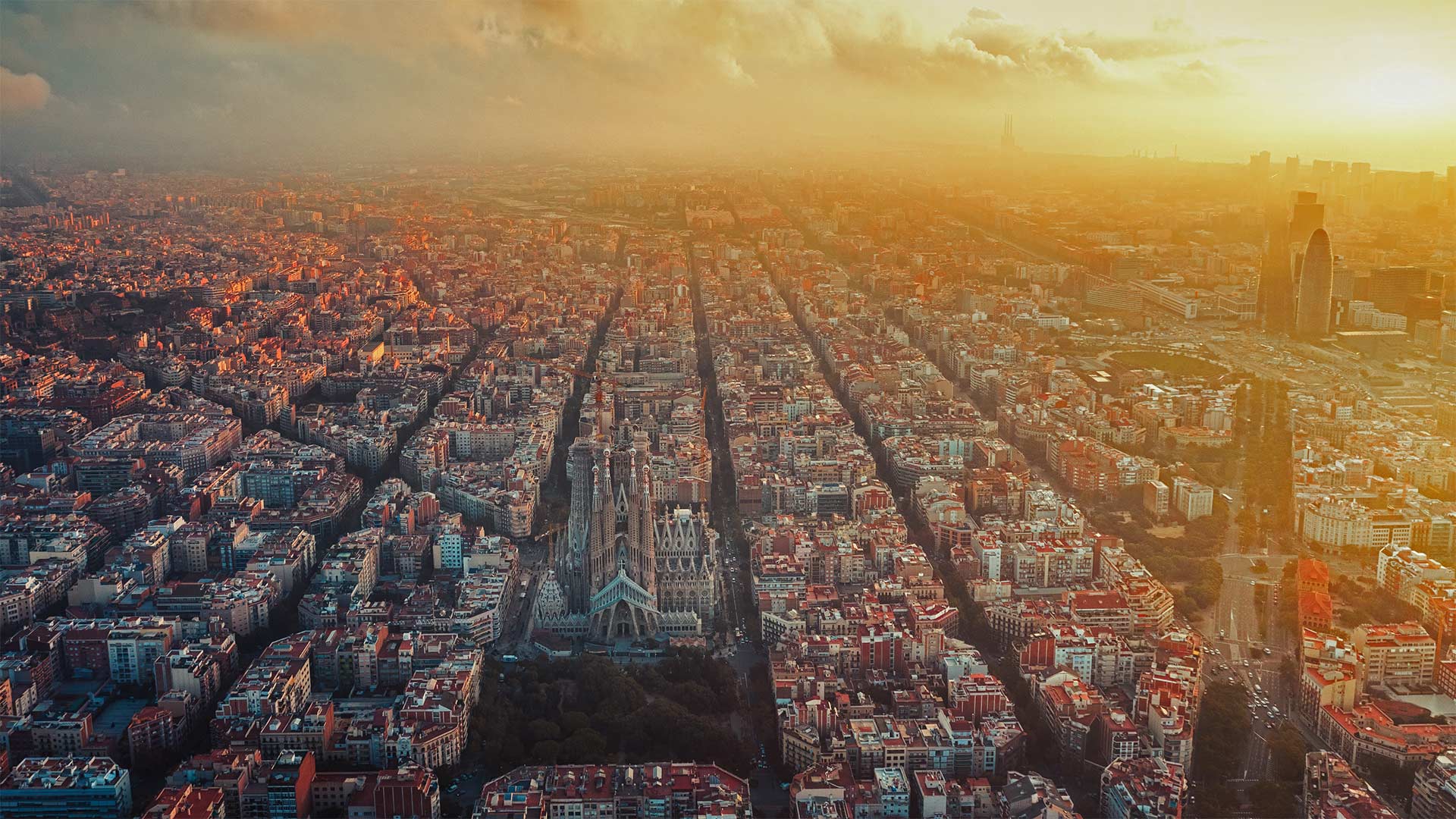
巴塞罗那城市上空,西班牙 Barcelona, Spain (© SW Photography/Getty Images)
城市规划永不停歇 Urban planning never stops
World Population Day
The bustling city streets of Barcelona seem as good a place as any to mark World Population Day. More and more of us are heading to the city. It's estimated that 2007 was the first year in which more people lived in cities than in rural areas. If current trends continue, by 2050 about two-thirds of the world population will be living in cities. City planners and government officials will need to account for this rapid increase as power grids, water supplies, public transit, and emergency services will all be stretched.
World Population Day was created by the United Nations in 1989 to focus attention on the urgency and importance of population issues. After hundreds of thousands of years, the world human population finally reached 1 billion around the year 1804. In just over 200 years since then it has exceeded 7.7 billion. It's expected to grow to around 8.5 billion in 2030, 9.7 billion in 2050, and 10.9 billion in 2100. How many is too many? What standard of living can we expect for people when the population exceeds 10 billion? And how many people can the planet sustain while also allowing nature to thrive? These are among the questions policy makers will confront as they consider the future of our world.
世界人口日
巴塞罗那繁华的城市街道似乎是纪念世界人口日的最佳场所。我们中越来越多的人正前往城市。据估计,2007年是城市人口比农村人口多的第一年。如果目前的趋势继续下去,到2050年,大约三分之二的世界人口将生活在城市。由于电网、供水、公共交通和应急服务都将捉襟见肘,城市规划者和政府官员将需要对这一快速增长做出解释。
世界人口日是联合国于1989年设立的,目的是使人们关注人口问题的紧迫性和重要性。几十万年后,世界人口终于在1804年左右达到10亿。从那以后的200多年里,它已经超过了77亿。预计2030年将增长到约85亿,2050年将增长到97亿,2100年将增长到109亿。多少是太多?当人口超过100亿时,我们能期望人们的生活水平如何?在允许自然繁荣的同时,这个星球还能维持多少人?这些是决策者在考虑世界未来时将面临的问题之一。
阿圭罗村庄, 韦斯卡, 西班牙 (© Francesco Carovillano/eStock)
格拉纳达的阿尔罕布拉,安达卢西亚省,西班牙 Alhambra in Granada, Andalucia, Spain (© Armand Tamboly/Getty Images)

格拉纳达的阿尔罕布拉,安达卢西亚省,西班牙 Alhambra in Granada, Andalucia, Spain (© Armand Tamboly/Getty Images)
绿宝石中的珍珠 Pearl among the emeralds
The Alhambra in Granada, Spain
The winds of history have long blown through the beautiful halls of the Alhambra. Though it had been the location of fortresses as far back as the 800s, construction of the Alhambra (Arabic for 'red castle') began in 1238 under the rule of Muhammad I Ibn al-Ahmar, founder of the Emirate of Granada. Ensuing leaders would continue construction of the complex, turning it into one of the finest examples of architecture from the historic Islamic world. The palace was the final hold of the Moors before the completion of the Christian Reconquista in 1492, when the Alhambra became the royal court of Ferdinand and Isabella. They greeted Christopher Columbus there later that same year.
While Spanish rulers would soon leave their imprint on the complex, with Spanish Renaissance architecture standing in contrast to the existing structures, the next few centuries would see the Alhambra gradually fall into disrepair and disuse, including a damaging occupation by Napolean's forces during the Peninsular War of 1807-1814. After Napolean's defeat, the grand palace was rediscovered among European and American travelers, which led to several extensive restorations. In 1984 the Alhambra was named a UNESCO World Heritage Site. Today it's one of Spain's most visited tourist destinations.
西班牙格拉纳达的阿罕布拉宫
历史之风早已吹过阿罕布拉美丽的大厅。尽管早在800年代它就已经是要塞所在地,但在格拉纳达酋长国创始人穆罕默德·伊本·艾哈迈尔(MuhammadIbnAl-Ahmar)的统治下,阿罕布拉(Alhambra)(阿拉伯语中“红色城堡”)的修建始于1238年。随后的领导人将继续修建该建筑群,使其成为历史上伊斯兰世界最优秀的建筑范例之一。1492年,基督教徒收复失地,阿罕布拉成为费迪南德和伊莎贝拉的皇家宫廷,在此之前,这座宫殿是摩尔人的最后据点。同年晚些时候,他们在那里迎接了克里斯托弗·哥伦布。
虽然西班牙统治者很快会在该建筑群上留下自己的印记,西班牙文艺复兴时期的建筑与现有建筑形成鲜明对比,但在接下来的几个世纪里,阿罕布拉宫将逐渐年久失修和废弃,包括1807-1814年半岛战争期间那不勒斯军队的破坏性占领。纳波利安战败后,欧洲和美国游客重新发现了这座宏伟的宫殿,这导致了几次大规模的修复。1984年,阿罕布拉被联合国教科文组织命名为世界遗产。今天,它是西班牙游客最多的旅游目的地之一。
黄昏下的马拉加老城,西班牙 Old town of Málaga, Spain (© Sean Pavone Photo/Getty Images)

黄昏下的马拉加老城,西班牙 Old town of Málaga, Spain (© Sean Pavone Photo/Getty Images)
2800年历史的老城 2,800 years of history
Málaga, Spain
Today we're visiting a city with over 2,800 years of history, one of the oldest in Europe. Málaga is said to have been founded by the Phoenicians in 770 BCE and today its year-round exceptional weather has made it the capital of tourism in Spain. Situated perfectly along the Costa Del Sol, an estimated six million tourists make the trip to this culturally rich mecca every year. If you can pull yourself away from the beautiful beaches, you'll find yourself abound in historical architecture, museums and the local cuisine of espetos, specially skewered sardines cooked over an open fire.
Aside from paying Pablo Picasso's birthplace a visit, the most well-known reason people make the journey to Málaga is to celebrate Holy Week. Handled differently than the silent and meditative celebrations throughout the rest of Spain, Málaga's 45 processions are essentially colorful, loud, and exciting parties throughout the streets commemorating The Passion of Jesus from Palm Sunday until Easter Sunday. The event has happened for more than 500 years with a vast number of floats and other processional materials being carried over from year to year.
西班牙马拉加
今天我们要参观一座有2800多年历史的城市,它是欧洲最古老的城市之一。据说,马拉加是腓尼基人在公元前770年建立的,今天,一年到头的特殊天气使其成为西班牙的旅游之都。坐落在太阳海岸沿线,每年估计有600万游客前往这个文化丰富的麦加。如果你能远离美丽的海滩,你会发现自己拥有丰富的历史建筑、博物馆和埃斯佩托的当地美食,特别是在明火上烹制的串制沙丁鱼。
除了参观巴勃罗·毕加索的出生地,人们前往玛拉加最著名的原因是庆祝圣周。与西班牙其他地区的静默和冥想庆祝活动不同,玛拉加的45场游行基本上是五颜六色、喧闹和激动人心的聚会,贯穿于整个街道,从棕榈周日到复活节周日,纪念耶稣的激情。这件事已经发生了500多年,每年都有大量的彩车和其他游行材料被带到这里。
